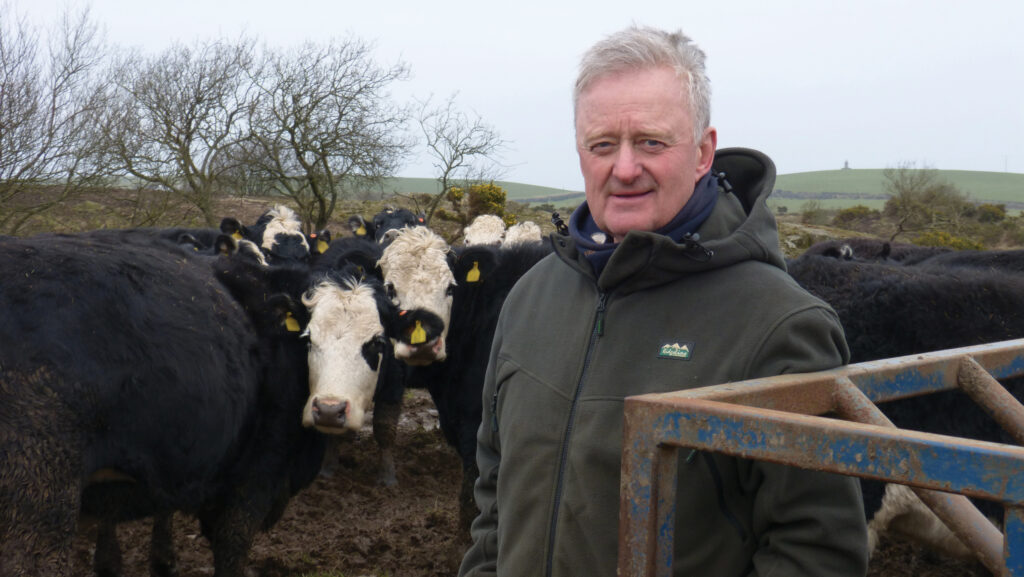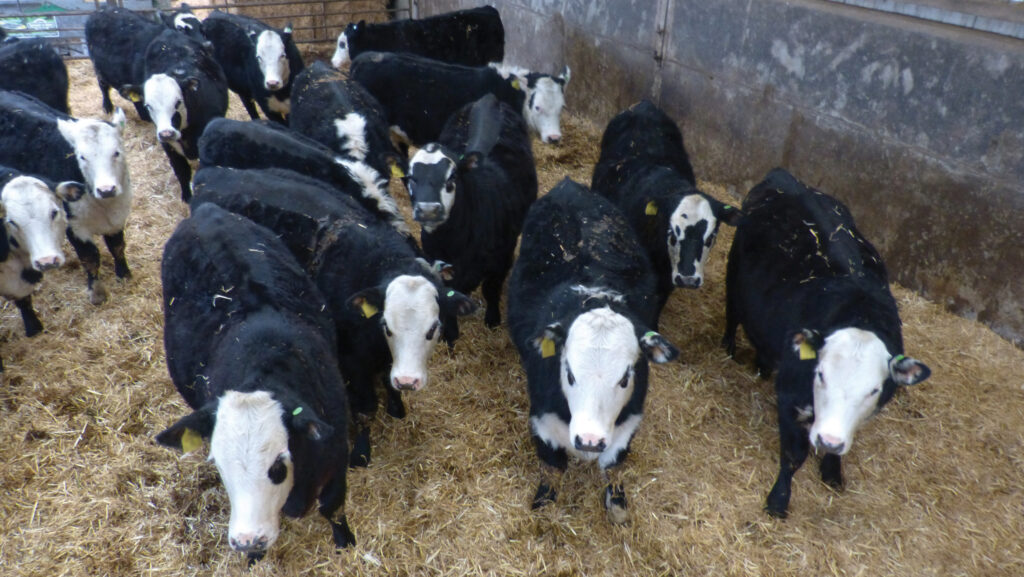How 15% replacement rate helped add £500 to heifer value
 © MAG/Michael Priestley
© MAG/Michael Priestley Improved cow longevity has given a Scottish suckler farmer the luxury of greater choice when selecting replacement females, leading to a valuable bulling heifer premium.
Wigtownshire-based farmer Robert Parker of Drumdow Farm, Stranraer, has sold bulling heifers from his herd of 200-220 Black Baldy (Hereford cross Angus) cows for 20 years.
Marketing through word of mouth and Facebook, he has sold 60-70 bulling heifers a year for a 50% premium over store price.
See also: Hereford herd grows demand with line-bred US genetics
Last year, the heifers averaged £1,550 at 13 months of age.
By comparison, his 11-month-old steers weighing 390kg averaged £1,150 at United Auctions’ first store sale at Stirling in April last year.
“I see this as a £500 benefit overall, as the heifers would usually be discounted to the steers if sold in a store ring,” explains Robert, who will sell his last batch of heifers this year.
Now in the process of selling the herd and putting the farm on the market, Robert, 63, settled on a criss-crossing system that prioritised maternal traits to increase the number of weaned calves by 10%, making profit every year.
Farm facts: Drumdow Farm, Stranraer, Wigtownshire

Robert Parker © MAG/Michael Priestley
- 210 Black Baldy suckler cows
- 170 Easycare ewes
- 226ha all in-bye
- 16ha barley grown mainly for home use
- 40ha silage ground, cut twice
- 100kW wind turbine
Functional cows
He says he established his current system in his mid-40s. “The past 20 or so years, I’ve tried to follow the top breeders by basing everything on the cow and maternal traits,” he explains.
“Big steers make a good income a head, but my system is based on functional cows and good maternal ability – steers are just a by-product.”
Robert bought Drumdow in 1987, when it was a 125ha (309-acre) grassland and arable farm and bought a further 101ha (250 acres) over the years.
Limited shed space necessitated outwintering on a 56ha (138-acre) area of rocky moor, gorse and sedge.
He would fill two silage clamps each summer. First-cut silage was fed to growing stock and second cut to wintering cows fed every three days on bale trailers.
Heifers and steers were housed in their first winter and sold in the spring. They were fed silage supplemented with 2kg/day mix, comprising one-third dark grains, one-third beet pulp and one-third rolled barley, to gain about 1kg/day.
Until the late 1990s, he ran a flying herd of dairy cross continental cows bought at markets and bred to a Charolais.
However, productivity was limited by slow calvings, fertility issues, and buying in Johne’s disease.
Breed change
Robert wanted to close the herd for the biosecurity benefits and breed his own cows that could winter and calve unassisted outside.
In 2006, he completed a Nuffield Scholarship on profitable suckler farming in temperate regions of Uruguay, Argentina and Australia.
Most businesses used Hereford and Angus-cross cows.
He decided to source Hereford and Angus bulls from breeders who were outwintering their cows and growing their bulls off forage alone to 1,000kg as mature bulls.
He bought several Angus bulls from Andrew Elliot’s Blackhaugh herd in Galashiels.
Hereford bulls came from John Douglas of Ervie Herefords, who imported line-bred genetics from a low-input herd in Montana, US, with recording going back to 1934.
Robert selected bulls off-farm on maternal estimated breeding values, focusing on calving ease and milk, while avoiding 200- and 400-day weight figures, as he believed this would lead to big, hungry cows.

© MAG/Michael Priestley
Maternal benefits
The genetic change paid off. Calves reared lifted from 84% to 94% (5% barren rate), calving assistance fell from 25% to 5%, and the bulling period was cut from 14 weeks to eight weeks in six years.
These factors all contributed to having more live calves to sell.
Robert then made a strategic change to sell cattle five or six months younger. He stopped selling strong stores and finishing heifers, and grew his herd from 120 to 220 cows.
The result was more selection pressure placed on females to breed a heifer that got in-calf at 13-14 months, calved at 550kg unassisted and gained up to 100kg in her third year off forage, putting her in good condition to outwinter. In 2005, he sold his first bulling heifers.
“We actually want cows to come off grass fat and lose 100kg through the winter,” explains Robert.
“Over the years, we have had to house six or seven cows that couldn’t build condition over summer,” he says, adding that this winter, every cow was outside.
Breeding
Robert wintered cows in groups of 30-35 and bulled in groups of 50, with two bulls serving each group to ensure a tight calving period.
Every female on a Hereford passport was served by an Angus bull and vice versa.
Visually, half the herd is black with a white face, with the rest either all black, or red with a white face.
Mature cows were run in four groups, alongside a heifer group and a first calver group, which got the best grazing.
Longevity
The system hinged on most cows lasting at least five calvings, and many rearing eight or nine calves, says Robert. “I went from having to have heifers to [being able to choose] heifers,” he explains.
A replacement rate of 25% from 84% calves weaned left a lot fewer heifers to select from than a replacement rate of 15% from 94% calves weaned, he adds.
He placed increasing scrutiny on locomotion, udder structure, wintering ability and temperament over the years, creating a herd that was easier to manage.
More recently, the herd was producing about 100 heifers a year. The biggest 10 were sold (to avoid cow size increasing) and the smallest 20 were bought by a buyer who calved them at 30 months of age.
Robert only required 30 heifers to maintain a herd of 210 cows, leaving 7 or so to sell.
Premium market
Robert held buyers’ interest year-round by posting pictures on the Drumdow Black Baldies Facebook page.
To ensure buyer confidence, every heifer had a fertility guarantee.
This meant a buyer with a heifer that failed to conceive, and a letter from their vet identifying a fertility issue, would be reimbursed to cover any losses for selling the animal as a store or finished animal.
Robert prioritised cattle health through membership of SRUC Veterinary Services’ Premium Cattle Health Scheme, with accreditation for Johne’s disease and bovine viral diarrhoea.
He says he has enjoyed repeat custom over the years, but stresses that the hybrid system meant he would only have customers for three or four years.
“After a while, they are set up with their own Black Baldy herd and want to self-replace themselves so only need bulls, so I’ve always been looking for new customers.”
Top tips on bull selection for cross breeding
- Select bulls from a farm that outwinters and rears on forage
- Prioritise milk and calving figures
- Avoid big bulls – about 1t mature weight is right
- Only use continentals as terminal sires
